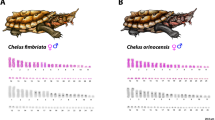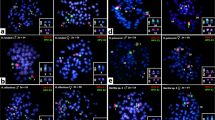Abstract
BOTH Leptaspis and Streptogyna represent very interesting groups from the point of view of the phylogeny of the Poaceae as their external morphology is very primitive. I collected Leptaspis cochleata Thw. and Streptogyna crinita Beauv. in woods at Dulva Kanda (about 4,000 ft.) in Ceylon while I was there in 1957. The root tips of the two species were fixed with Navashin solution at the habitats and, after my return to Japan, dehydrated and embedded in paraffin. Sections were cut at 15µ and stained by Newton's gentian violet method. Two individuals of S. crinita and one individual of L. cochleata were used for chromosome observation. As shown in Figs. 1 and 2, both species had 2n = 24. The chromosomes of L. cochleata are clearly larger than those of S. crinita.
This is a preview of subscription content, access via your institution
Access options
Subscribe to this journal
Receive 51 print issues and online access
$199.00 per year
only $3.90 per issue
Buy this article
- Purchase on Springer Link
- Instant access to full article PDF
Prices may be subject to local taxes which are calculated during checkout
Similar content being viewed by others
References
Hubbard, C. E., Hook. Ic. Pl., 36, Tab. 3572 (1956).
Jacques-Felix, H., J. Agric. Trop., 2, 427 (1955). Metcalfe, C. R., Bot. Mag. Tokyo, 69, 391 (1956).
Author information
Authors and Affiliations
Rights and permissions
About this article
Cite this article
TATEOKA, T. Somatic Chromosomes of Leptaspis and Streptogyna (Poaceae). Nature 182, 1619–1620 (1958). https://doi.org/10.1038/1821619b0
Issue Date:
DOI: https://doi.org/10.1038/1821619b0
This article is cited by
-
Cytology and genetics of forage grasses
The Botanical Review (1961)
Comments
By submitting a comment you agree to abide by our Terms and Community Guidelines. If you find something abusive or that does not comply with our terms or guidelines please flag it as inappropriate.



